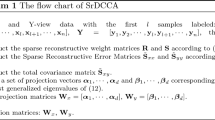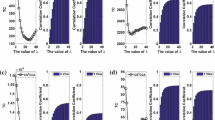Abstract
Understanding and analyzing multi-view data is a fundamental research topic of feature learning for a wide range of practical applications such as image classification. Canonical correlation analysis (CCA) is a popular unsupervised method of analyzing multi-view data, which captures common subspace of two groups of variable sets by maximizing the correlations between them. However, traditional CCA ignores the underlying geometric structure within dataset, which shows great power in describing data distribution, and thus fails in some tasks such as classification. To handle this limitation, this paper proposes an improved CCA variant of Nonnegative Constrained Graph regularized CCA (NCGCCA). Specifically, we improve CCA to NCGCCA with the following two contributions. Firstly, we develop a nonnegative constrained graph based self-representation to explore the underlying group-wise structure within dataset. Secondly, based on the proposed informative representation, we offer a graph embedding schema to incorporate the underlying structure into CCA. Experiments of image classification on four face datasets including Yale, ORL, UMIST, and YaleB demonstrate the efficacy of NCGCCA compared with existing baseline CCA methods.











Similar content being viewed by others
Explore related subjects
Discover the latest articles and news from researchers in related subjects, suggested using machine learning.References
Wu F, Jing XY, Yue D (2017) Multi-view discriminant dictionary learning via learning view-specific and shared structured dictionaries for image classification. Neural Process Lett 45(2):649–666
Wan J, Wang H, Yang M (2017) Cost sensitive semi-supervised canonical correlation analysis for multi-view dimensionality reduction. Neural Process Lett 45(2):411–430
Sun S, Zhang Q (2011) Multiple-view multiple-learner semi-supervised learning. Neural Process Lett 34(3):229–240
Wang F, Zhang D (2013) A new locality-preserving canonical correlation analysis algorithm for multi-view dimensionality reduction. Neural Process Lett 37(2):135–146
Hotelling H (1936) Relations between two sets of variates. Biometrika 28(3/4):321–377
Yuan YH, Sun QS, Ge HW (2014) Fractional-order embedding canonical correlation analysis and its applications to multi-view dimensionality reduction and recognition. Pattern Recognit 47(3):1411–1424
Farquhar J, Hardoon D, Meng H, Shawe-taylor JS, Szedmak S (2006) Two view learning: Svm-2k, theory and practice. In: Advances in neural information processing systems, pp 355–362
Yang J, Sun QS (2017) A novel generalized fuzzy canonical correlation analysis framework for feature fusion and recognition. Neural Process Lett 46(2):521–536
Kakade SM, Foster DP (2007) Multi-view regression via canonical correlation analysis. In: International conference on computational learning theory. Springer, pp 82–96
Blaschko MB, Lampert CH (2008) Correlational spectral clustering. In: Computer vision and pattern recognition. IEEE, pp 1–8
Chaudhuri K, Kakade SM, Livescu K, Sridharan K (2009) Multi-view clustering via canonical correlation analysis. In: Machine learning. ACM, pp 129–136
Lai PL, Fyfe C (2000) Kernel and nonlinear canonical correlation analysis. Int J Neural Syst 10(05):365–377
Luo Y, Tao D, Ramamohanarao K, Xu C, Wen Y (2015) Tensor canonical correlation analysis for multi-view dimension reduction. IEEE Trans Knowl Data Eng 27(11):3111–3124
Wang SJ, Yan WJ, Sun T, Zhao G, Fu X (2016) Sparse tensor canonical correlation analysis for micro-expression recognition. Neurocomputing 214:218–232
Andrew G, Arora R, Bilmes J, Livescu K (2013) Deep canonical correlation analysis. In: International conference on machine learning, pp 1247–1255
Srivastava N, Salakhutdinov RR (2012) Multimodal learning with deep boltzmann machines. In: Advances in neural information processing systems, pp 2222–2230
Ngiam J, Khosla A, Kim M, Nam J, Lee H, Ng AY (2011) Multimodal deep learning. In: International conference on machine learning, pp 689–696
Liu B, Jing L, Yu J, Li J (2016) Robust graph learning via constrained elastic-net regularization. Neurocomputing 171:299–312
Hu R, Zhu X, Cheng D, He W, Yan Y, Song J, Zhang S (2017) Graph self-representation method for unsupervised feature selection. Neurocomputing 220:130–137
Peng C, Kang Z, Cheng Q (2017) Integrating feature and graph learning with low-rank representation. Neurocomputing 249:106–116
Li S, Zeng C, Fu Y, Liu S (2017) Optimizing multi-graph learning based salient object detection. Signal Process Image Commun 55:93–105
Lou S, Zhao X, Chuang Y, Yu H, Zhang S (2016) Graph regularized sparsity discriminant analysis for face recognition. Neurocomputing 173:290–297
Peng Y, Wang S, Long X, Lu BL (2015) Discriminative graph regularized extreme learning machine and its application to face recognition. Neurocomputing 149:340–353
Sun T, Chen S (2007) Locality preserving cca with applications to data visualization and pose estimation. Image Vis Comput 25(5):531–543
Peng Y, Zhang D, Zhang J (2010) A new canonical correlation analysis algorithm with local discrimination. Neural Process Lett 31(1):1–15
Zhang X, Guan N, Luo Z, Lan L (2012) Discriminative locality preserving canonical correlation analysis. In: Chinese conference on pattern recognition. Springer, pp 341–349
Guan N, Zhang X, Luo Z, Lan L (2012) Sparse representation based discriminative canonical correlation analysis for face recognition. In: Machine learning and applications. IEEE, vol 1, pp 51–56
Zu C, Zhang D (2016) Canonical sparse cross-view correlation analysis. Neurocomputing 191:263–272
Wright J, Yang AY, Ganesh A, Sastry SS, Ma Y (2009) Robust face recognition via sparse representation. IEEE Trans Pattern Anal Mach Intell 31(2):210–227
Yan S, Xu D, Zhang B, Zhang HJ, Yang Q, Lin S (2007) Graph embedding and extensions: a general framework for dimensionality reduction. IEEE Trans Pattern Anal Mach Intell 29(1):40–51
He X, Niyogi P (2003) Locality preserving projections. In: Neural information processing systems, vol 16
Qiao L, Chen S, Tan X (2010) Sparsity preserving projections with applications to face recognition. Pattern Recognit 43(1):331–341
Gui J, Sun Z, Jia W, Hu R, Lei Y, Ji S (2012) Discriminant sparse neighborhood preserving embedding for face recognition. Pattern Recognit 45(8):2884–2893
Lu CY, Min H, Gui J, Zhu L, Lei YK (2013) Face recognition via weighted sparse representation. J Vis Commun Image Represent 24(2):111–116
Cheng B, Yang J, Yan S, Fu Y, Huang TS (2010) Learning with \({{l}_{1}}\)-graph for image analysis. IEEE Trans Image Process 19(4):858–866
Roweis ST, Saul LK (2000) Nonlinear dimensionality reduction by locally linear embedding. Science 290(5500):2323–2326
Wang J, Wang F, Zhang C, Shen HC, Quan L (2009) Linear neighborhood propagation and its applications. IEEE Trans Pattern Anal Mach Intell 31(9):1600–1615
He R, Zheng WS, Hu BG, Kong XW (2011) Nonnegative sparse coding for discriminative semi-supervised learning. In: Computer vision and pattern recognition. IEEE, pp 2849–2856
Vo N, Moran B, Challa S (2009) Nonnegative-least-square classifier for face recognition. In: International symposium on neural networks. Springer, pp 449–456
Liu G, Lin Z, Yu Y (2010) Robust subspace segmentation by low-rank representation. In: International conference on machine learning, pp 663–670
Belhumeur PN, Hespanha JP, Kriegman DJ (1997) Eigenfaces vs. fisherfaces: recognition using class specific linear projection. IEEE Trans Pattern Anal Mach Intell 19(7):711–720
Samaria FS, Harter AC (1994) Parameterisation of a stochastic model for human face identification. In: Applications of computer vision. IEEE, pp 138–142
Graham DB, Allinson NM (1998) Characterising virtual eigensignatures for general purpose face recognition. In: Face recognition. Springer, pp 446–456
Lee KC, Ho J, Kriegman DJ (2005) Acquiring linear subspaces for face recognition under variable lighting. IEEE Trans Pattern Anal Mach Intell 27(5):684–698
Hoegaerts L, Suykens JA, Vandewalle J, De Moor B (2005) Subset based least squares subspace regression in rkhs. Neurocomputing 63:293–323
Lu X, Li X (2014) Group sparse reconstruction for image segmentation. Neurocomputing 136:41–48
Elad M, Figueiredo MA, Ma Y (2010) On the role of sparse and redundant representations in image processing. Proc IEEE 98(6):972–982
Bruckstein AM, Donoho DL, Elad M (2009) From sparse solutions of systems of equations to sparse modeling of signals and images. SIAM Rev 51(1):34–81
Xu Y, Zhang D, Yang J, Yang JY (2011) A two-phase test sample sparse representation method for use with face recognition. IEEE Trans Circuits Syst Video Technol 21(9):1255–1262
Wright J, Ma Y, Mairal J, Sapiro G, Huang TS, Yan S (2010) Sparse representation for computer vision and pattern recognition. Proc IEEE 98(6):1031–1044
Guan N, Tao D, Luo Z, Yuan B (2011) Non-negative patch alignment framework. IEEE Trans Neural Netw 22(8):1218–1230
Fazel M (2002) Matrix rank minimization with applications. PhD thesis, Stanford University
Acknowledgements
This work was supported by the National Natural Science Foundation of China [61806213, U1435222] and the National High-tech R&D Program [2015AA020108].
Author information
Authors and Affiliations
Corresponding author
Additional information
Publisher's Note
Springer Nature remains neutral with regard to jurisdictional claims in published maps and institutional affiliations.
Rights and permissions
About this article
Cite this article
Tan, H., Zhang, X., Lan, L. et al. Nonnegative Constrained Graph Based Canonical Correlation Analysis for Multi-view Feature Learning. Neural Process Lett 50, 1215–1240 (2019). https://doi.org/10.1007/s11063-018-9904-7
Published:
Issue Date:
DOI: https://doi.org/10.1007/s11063-018-9904-7




